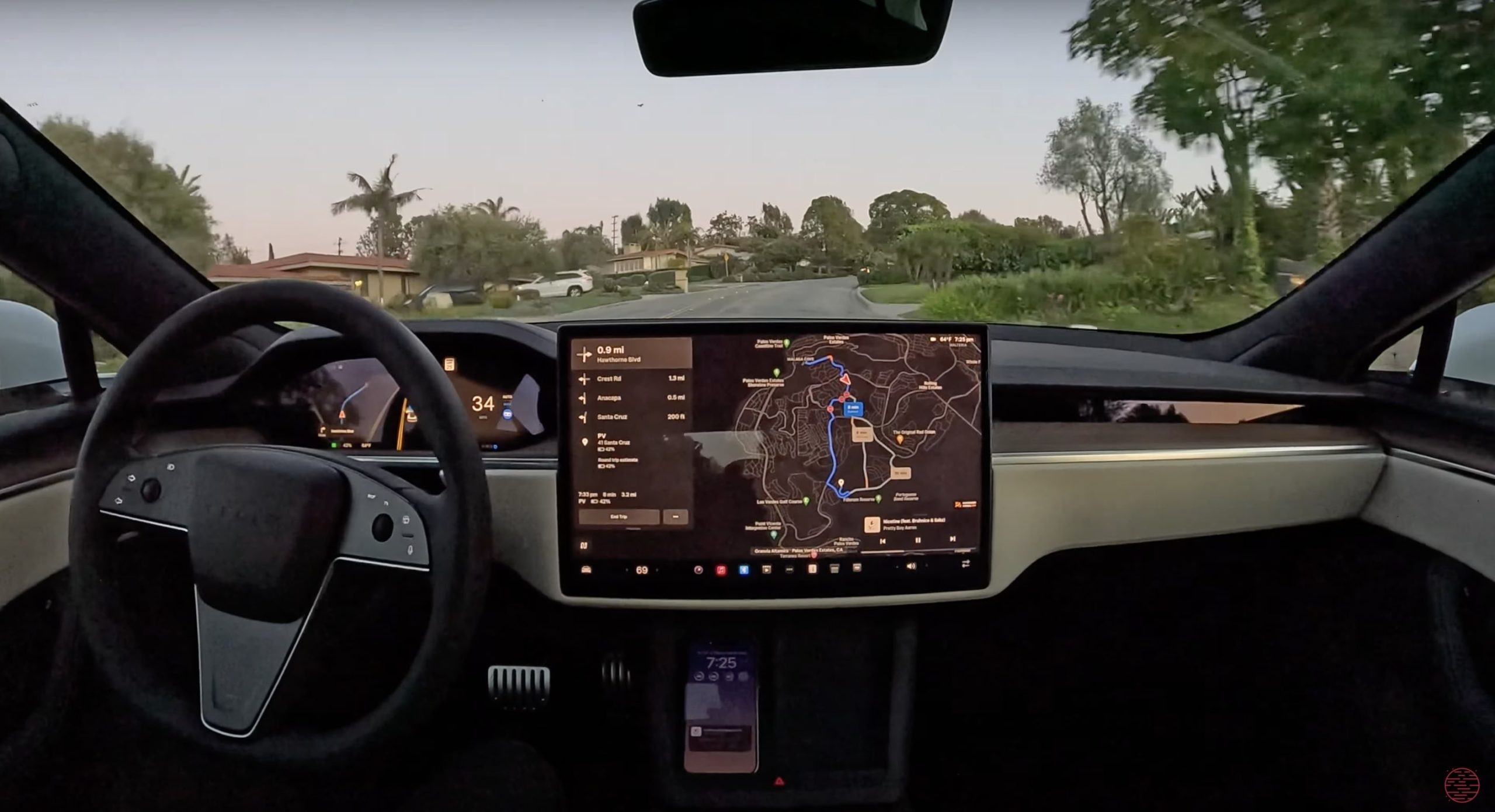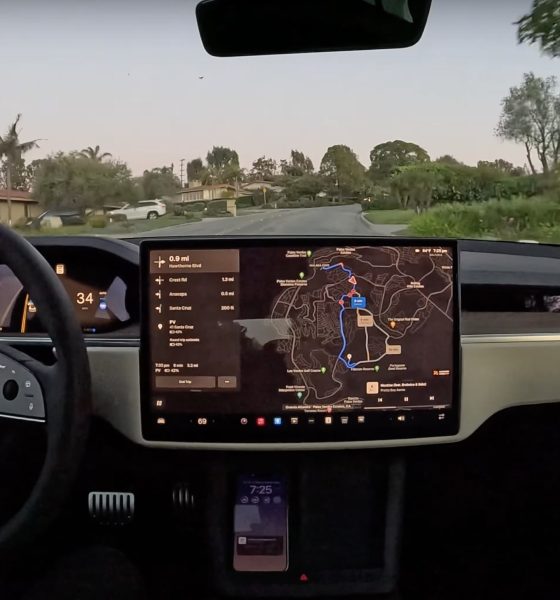Tesla has highlighted multiple recent Full Self-Driving (FSD) experiences from customers with the v12 software, as shared in a mega-thread on X this week.
On Tuesday, the main Tesla X account shared an article featuring multiple FSD videos from customers across the platform, showing a number of edge cases and how the vehicles handled them. The drivers in the videos are using either FSD Supervised v12.3.4 or v12.3.6, and Tesla notes the specific situations tackled by the semi-automated driving system in each video.
The so-called article, which is essentially just the series of seven videos, details different edge-case traffic situations, showing off some of the positive encounters customers have recently had with the neural net-based system. We’ve embedded each video below, or you can check out the article directly on X here.
Navigating a construction zone & taking into account signs from workers indicating when to proceed
FSD 12.3.6 vs road works.
This was quite impressive!
Going up this hill, there were road works causing my lane to be closed. Workers were there with signs indicating when we could move.
Without hesitation, FSD put the indicator on and went around onto the other side, cleared the… pic.twitter.com/uazXrd8diN— Darryn Appleton (@DrTeslaFSD) May 16, 2024
Making a turn in a busy area with a large number of pedestrians crossing the street
How many pedestrians can FSD track simultaneously?
All of them.LA is nothing like Manhattan but we have this little area of town that gets super busy with tourists and a great test for FSD at low speed negotiation around pedestrians and traffic. The key for success is to always… pic.twitter.com/ASWWA0T3Ru
— Edge Case (@edgecase411) May 6, 2024
Driving like a human would—with good spatial awareness & reaction time
Thank you @Tesla and @elonmusk for #FSD v12.3.4 — avoiding hazards, oncoming traffic, merging in/out of lanes. Insanely good. Human. pic.twitter.com/PS8gnkxeSp
— CyberMan (@thalerz) April 15, 2024
Road etiquette matters
Navigating through heavy traffic in my Tesla Model X with FSD (Supervised) v12.3.4 today, my car showed impeccable manners, stopping to let a fellow driver pass. A true example of how technology can enhance road etiquette! pic.twitter.com/0iQFbg5iQc
— TeslaFamOnBoard – Jose Negron⚡️??? (@TeslaFamOnBoard) April 15, 2024
Braking for another vehicle despite having right of way
FSD deals with driver failing to yield due to light malfunction?@Tesla @cityoflubbock @LubbockPolice
Guys can we get Lubbock Traffic control on X! Would make reporting much easier!
9 Major Accidents Avoided! Save lives & drive a Tesla! pic.twitter.com/74EKlMg2Ze— Allen Iron (@myprojectpluto) May 23, 2024
Adjusting to real-life situations that require temporary overriding of traffic rules
Nothing to see here.
Just a robot car making a left at a light and calmly driving over a double yellow line avoiding a garbage truck.
No other car you can buy is capable of anything close to this.
FSD 12.3.4 pic.twitter.com/AKWHQmQ3Qu— Pete Balls to the wall FSD ?? (@kylaschwaberow) April 13, 2024
Giving adequate space to pedestrians
FSD V12 prioritizes pedestrian safety more than most human drivers pic.twitter.com/MH45CAo544
— AI DRIVR (@AIDRIVR) May 19, 2024
While it’s not entirely clear where Tesla’s social media and advertising divisions stand following multiple rounds of layoffs in the past several weeks, the company has taken no break from sharing select ads across socials.
Throughout late last year and early this year, Tesla’s focus on using social media platforms, especially X, as a means of advertising was becoming more apparent than ever. Meanwhile, many shareholders had been calling for the company to increase its advertising presence in general, especially for the sake of helping to educate the public on misconceptions about electric vehicles (EVs).
Many of the company’s executives had also been interacting directly with fans and shareholders on the social media platform in recent months, though at least a few of said executives have since departed. Tesla has also been highly focused on FSD ahead of the unveiling of a future robotaxi platform in August, recently offering free one-month trials of the software for the first time ever, and rolling out mandatory demos of the system with purchase of a vehicle.
The company is also seemingly preparing to launch FSD in China and potentially other markets in the coming months, being granted tentative approval in April. Recent wording spotted in a Tesla customer vehicle in China also suggests that FSD could be coming to the country sooner rather than later.
What are your thoughts? Let me know at zach@teslarati.com, find me on X at @zacharyvisconti, or send us tips at tips@teslarati.com.

News
Tesla (TSLA) receives positive outlook and $551 PT from Canaccord Genuity
He also maintained a “Buy” rating for TSLA stock over the company’s improving long-term outlook, which is driven by autonomy and robotics.

Canaccord Genuity analyst George Gianarikas raised his Tesla (NASDAQ:TSLA) price target from $482 to $551. He also maintained a “Buy” rating for TSLA stock over the company’s improving long-term outlook, which is driven by autonomy and robotics.
The analyst’s updated note
Gianarikas lowered his 4Q25 delivery estimates but pointed to several positive factors in the Tesla story. He noted that EV adoption in emerging markets is gaining pace, and progress in FSD and the Robotaxi rollout in 2026 represent major upside drivers. Further progress in the Optimus program next year could also add more momentum for the electric vehicle maker.
“Overall, yes, 4Q25 delivery expectations are being revised lower. However, the reset in the US EV market is laying the groundwork for a more durable and attractive long-term demand environment.
“At the same time, EV penetration in emerging markets is accelerating, reinforcing Tesla’s potential multi‑year growth runway beyond the US. Global progress in FSD and the anticipated rollout of a larger robotaxi fleet in 2026 are increasingly important components of the Tesla equity story and could provide sentiment tailwinds,” the analyst wrote.
Tesla’s busy 2026
The upcoming year would be a busy one for Tesla, considering the company’s plans and targets. The autonomous two-seat Cybercab has been confirmed to start production sometime in Q2 2026, as per Elon Musk during the 2025 Annual Shareholder Meeting. Apart from this, Tesla is also expected to unveil the next-generation Roadster on April 1, 2026. Apart from this, Tesla is expected to start high-volume production of the Tesla Semi in Nevada next year.
Apart from vehicle launches, Tesla has expressed its intentions to significantly ramp the rollout of FSD to several regions worldwide, such as Europe. Plans are also underway to launch more Robotaxi networks in several more key areas across the United States.
News
Waymo sues Santa Monica over order to halt overnight charging sessions
In its complaint, Waymo argued that its self-driving cars’ operations do not constitute a public nuisance, and compliance with the city’s order would cause the company irreparable harm.

Waymo has filed a lawsuit against the City of Santa Monica in Los Angeles County Superior Court, seeking to block an order that requires the company to cease overnight charging at two facilities.
In its complaint, Waymo argued that its self-driving cars’ operations do not constitute a public nuisance, and compliance with the city’s order would cause the company irreparable harm.
Nuisance claims
As noted in a report from the Los Angeles Times, Waymo’s two charging sites at Euclid Street and Broadway have operated for about a year, supporting the company’s growing fleet with round-the-clock activity. Unfortunately, this has also resulted in residents in the area reportedly being unable to sleep due to incessant beeping from self-driving taxis that are moving in and out of the charging stations around the clock.
Frustrated residents have protested against the Waymos by blocking the vehicles’ paths, placing cones, and “stacking” cars to create backups. This has also resulted in multiple calls to the police.
Last month, the city issued an order to Waymo and its charging partner, Voltera, to cease overnight operations at the charging locations, stating that the self-driving vehicles’ activities at night were a public nuisance. A December 15 meeting yielded no agreement on mitigations like software rerouting. Waymo proposed changes, but the city reportedly insisted that nothing would satisfy the irate residents.
“We are disappointed that the City has chosen an adversarial path over a collaborative one. The City’s position has been to insist that no actions taken or proposed by Waymo would satisfy the complaining neighbors and therefore must be deemed insufficient,” a Waymo spokesperson stated.
Waymo pushes back
In its legal complaint, Waymo stated that its “activities at the Broadway Facilities do not constitute a public nuisance.” The company also noted that it “faces imminent and irreparable harm to its operations, employees, and customers” from the city’s order. The suit also stated that the city was fully aware that the Voltera charging sites would be operating around the clock to support Waymo’s self-driving taxis.
The company highlighted over one million trips in Santa Monica since launch, with more than 50,000 rides starting or ending there in November alone. Waymo also criticized the city for adopting a contentious strategy against businesses.
“The City of Santa Monica’s recent actions are inconsistent with its stated goal of attracting investment. At a time when the City faces a serious fiscal crisis, officials are choosing to obstruct properly permitted investment rather than fostering a ‘ready for business’ environment,” Waymo stated.
News
Tesla FSD v14.2.2 is getting rave reviews from drivers
So far, early testers have reported buttery-smooth drives with confident performance, even at night or on twisty roads.

Tesla Full Self-Driving (Supervised) v14.2.2 is receiving positive reviews from owners, with several drivers praising the build’s lack of hesitation during lane changes and its smoother decision-making, among others.
The update, which started rolling out on Monday, also adds features like dynamic arrival pin adjustment. So far, early testers have reported buttery-smooth drives with confident performance, even at night or on twisty roads.
Owners highlight major improvements
Longtime Tesla owner and FSD user @BLKMDL3 shared a detailed 10-hour impression of FSD v14.2.2, noting that the system exhibited “zero lane change hesitation” and “extremely refined” lane choices. He praised Mad Max mode’s performance, stellar parking in locations including ticket dispensers, and impressive canyon runs even in dark conditions.
Fellow FSD user Dan Burkland reported an hour of FSD v14.2.2’s nighttime driving with “zero hesitations” and “buttery smooth” confidence reminiscent of Robotaxi rides in areas such as Austin, Texas. Veteran FSD user Whole Mars Catalog also demonstrated voice navigation via Grok, while Tesla owner Devin Olsen completed a nearly two-hour drive with FSD v14.2.2 in heavy traffic and rain with strong performance.
Closer to unsupervised
FSD has been receiving rave reviews, even from Tesla’s competitors. Xpeng CEO He Xiaopeng, for one, offered fresh praise for FSD v14.2 after visiting Silicon Valley. Following extended test drives of Tesla vehicles running the latest FSD software, He stated that the system has made major strides, reinforcing his view that Tesla’s approach to autonomy is indeed the proper path towards autonomy.
According to He, Tesla’s FSD has evolved from a smooth Level 2 advanced driver assistance system into what he described as a “near-Level 4” experience in terms of capabilities. While acknowledging that areas of improvement are still present, the Xpeng CEO stated that FSD’s current iteration significantly surpasses last year’s capabilities. He also reiterated his belief that Tesla’s strategy of using the same autonomous software and hardware architecture across private vehicles and robotaxis is the right long-term approach, as it would allow users to bypass intermediate autonomy stages and move closer to Level 4 functionality.










